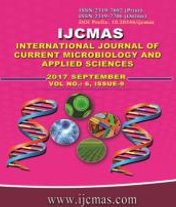


 National Academy of Agricultural Sciences (NAAS)
National Academy of Agricultural Sciences (NAAS)

|
PRINT ISSN : 2319-7692
Online ISSN : 2319-7706 Issues : 12 per year Publisher : Excellent Publishers Email : editorijcmas@gmail.com / submit@ijcmas.com Editor-in-chief: Dr.M.Prakash Index Copernicus ICV 2018: 95.39 NAAS RATING 2020: 5.38 |
A field experiment was conducted at Agricultural Research Institute Rajendranagar, Hyderabad during kharif 2014 to study the “Water management for different systems of rice (Oryza sativa L.) cultivation in puddled soils”. The treatments comprises of three systems of cultivations (direct seeding with drum seeder, transplanting with machine and conventional transplanting) as main treatments and four irrigation regimes (irrigation of 5 cm, when water level falls below 5 cm from soil surface in field water tube, irrigation of 5 cm, when water level falls below 10 cm from soil surface in field water tube, irrigation of 5 cm at 3 days after disappearance of ponded water and recommended submergence of 2-5 cm water level as per crop stage). Machine transplanting recorded significantly higher grain and straw (6088 and 6954 kg ha-1, respectively) yields over drum seeding method (5308 and 6295 kg ha-1, respectively) and was on par with conventional transplanting method (5926 and 6886 kg ha-1, respectively). Significantly higher water use efficiency (4.7 kg mm-1) was recorded with machine transplanting compared to drum seeding (4.0 kg mm-1) and was on par with conventional transplanting (4.5 kg mm-1). Among different irrigation regimes Recommended submergence of 2-5 cm water level (I4) recorded significantly higher grain and straw yield (6148 and 7039 kg ha-1, respectively) and was on par with irrigation of 5 cm when water falls below 5 cm from soil surface in field water tube (I2) (5751 and 6872 kg ha-1, respectively). There was saving of water to the extent of 28.5 (1271.7 mm), 40.4 per cent (1085.0 mm) and 36.5 (1154.7mm), by I1, I2 and I3 respectively compared to recommended practice of irrigation (1819.7mm), though there was reduction of grain yield by 5.4, 12.5 and 6.5 per cent, under I1, I2 and I3 respectively.
 |
 |
 |
 |
 |